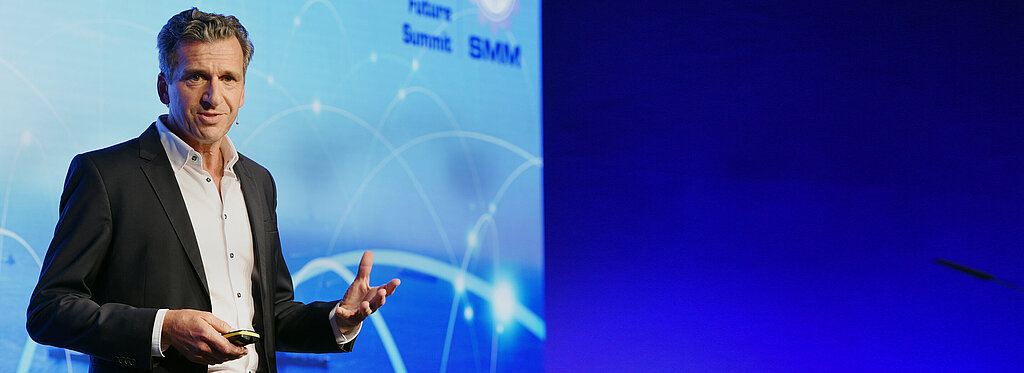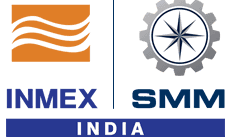Hamburg, 06-09-2022 – “Finally we are back in the real world”, said Claus-Ulrich Selbach, Business Unit Director Maritime and Technology Fairs at Hamburg Messe und Congress, in his welcoming address opening the Maritime Future Summit (MFS) in the crowded meeting room “Chicago” on Hamburg’s trade fair campus on Monday, 05-09-2022. After the conference programme had to be moved online last time due to the pandemic, it was a wonderful experience to be able to welcome guests to a live event in Hamburg again, Selbach added. Exhibitor and visitor numbers are back to pre-Covid levels again, a clear indication that the industry has been longing for face-to-face interaction and opportunities to exchange views and ideas in person.
The MFS is traditionally held the day before the opening of the trade fair itself, which takes place from 6 to 9 September this year. While many of the roughly 2,000 exhibiting companies and organisations were putting the finishing touches on their stands in the big halls, top-flight experts were already discussing opportunities and strategies for the next phase of the digital transformation in the maritime sector at the MFS, sponsored by the China Classification Society (CSS). "There are many highly attractive individual solutions that have made the market more efficient. The pandemic, with its massive restrictions, has been a key factor in stimulating innovative thinking. Now it is important for all stakeholders to network and establish smart alliances and multidisciplinary solutions that can move us ahead," said moderator Dr Volker Bertram, a professor at World Maritime University. There are many reasons the industry needs to take the next step to innovate now. Covid-19, the climate crisis, the Ukraine war and supply chain disruptions are just a few of the challenges requiring a digital revolution and sustainable solutions. Krischan Förster, editor-in-chief of HANSA magazine and co-organiser of the MFS, gave some recent examples of successful cooperation partnerships. He mentioned BLOM Maritime and Aveva with their 3D scans, or Semcon and Jotun with their Hull Skating solution (HSS) for keeping algae growth off the hulls of large ships, as model cases showing the power of cooperation. "We are on the threshold of a new era," said Förster.
Panel 1: Connecting Digital Technologies
Under the heading of "Connecting Digital Technologies”, the day's first discussion panel, including Donya-Florence Amer (CIO, Hapag-Lloyd), Dr-Ing Pierre Sames (Strategic Development Director, DNV), Solène Guéré (Vice President, Notilo Plus) and Kenneth Goh (General Manager, Knud E. Hansen), explored various approaches to successful networking. In her keynote address, Donya-Florence Amer examined the power of exponential technologies and their business impact on Hapag-Lloyd, human communities and the planet. She insisted that “we all have what it takes to achieve our objective. People still love to consume. That gives us dependable safety for investments." Right now Hapag Lloyd is primarily investing in its IT infrastructure. Up to 400 experts are working in this field at the shipping company, which intends to hire more. It is looking for skilled people from around the world who have an affinity for all things digital and are innovation-driven. "The transformation we are experiencing is not one of technology. The technology is already there. The transformation is of a cultural nature. And that means we need a specific mindset." Amer closed her speech with a positive outlook: "The beauty in this challenge we are all facing lies in our common goal: to protect the climate. This focus on sustainability will release new energies and give rise to new cooperative partnerships within and beyond our industry."
In his speech Pierre Sames from DNV described how digital technologies can expand and improve ship hull inspections. Drawing on more than a decade of research and development, DNV has begun to incorporate drone inspections into its surveys to assess the structural integrity and the condition of coatings inside ships. "Using 3D models of ship hulls we can plan the flight of the drone precisely. The drones deliver top quality streamed images in real time. It is like being present on board. This allows users of this technology to collect data and make decisions more safely, at lower cost, and more reliably." The procedure is being rolled out step-by-step. "It cannot be applied on all ship types. We are watching the development very closely," said Sames.
Solène Guéré gave some fascinating insights into the work of Notilo Plus. This relatively young French company specialises in subsea robots performing high-precision, data-based, consistent underwater inspections. The company has designed drones with automation features. Fitted with a high resolution camera and powerful searchlights as well as additional sensors, these craft can be used as remote-controlled vehicles. "It was our goal to provide divers with a solution that is simple to operate and can return reliable, high-quality data to the surface: localised images, stable images, taken at consistent distances from the ship’s hull," said Guéré.
Kenneth Goh, General Manager at the Danish ship design firm Knud E. Hansen, focused his presentation on the question how design can be communicated in a comprehensible manner. Based on recent neurobiological findings he explained how Virtual Reality can play key roles in multinational design projects to bring together people, ideas and technologies. "We have not fully exploited the potential of these technologies so far. Major portions of the industry are still marked by a certain complacency and needless traditionalism," said Goh, encouraging the industry to embrace innovation. He estimates it will take another 10 to 20 years for VR to be accepted as an industry standard.
Panel 2: Connecting Data to Move Ahead
The day's second panel, featuring an equally prominent selection of top-ranking experts including Ma Jilin (Director of Intelligent Technology and Safety Laboratory at CSS), Ludmila Seppälä (Director Business Development Marine Industry at Cadmatic), Sean Fernback (CEO, Wärtsilä Voyage) and Patrick Müller (Business Owner Digitalization, Siemens Energy Marine), discussed specific measures that could accelerate the digital transition in the market.
In his speech, Ma Jilin, Director of Intelligent Technology and Safety Laboratory at CSS, presented the status quo from an Asian perspective. "Before the year 2020 the Asian market hardly showed any interest in these questions. But the pandemic caused an almost explosive development," said Jilin. But reinventing the wheel isn't always necessary, he said. Sometimes taking a look at related industries such as aerospace or the automotive sector can be helpful.
On a similar note, Ludmila Seppälä, Director Business Development Marine Industry at Cadmatic, described the enormous development the industry has undergone in recent months. Her company uses 3D models as 'digital twins' when designing ships. In this process, information not only flows from the digital asset (the 3D model) to the physical world but also in the opposite direction, feeding information from the shipyard and production sites back to the digital model. "Users can access all of this data using the latest visualisation technologies. This enables them to extract all necessary data whenever they need them," she explained. Notwithstanding all the hopes being pinned on Artificial Intelligence, human intelligence is indispensable, she emphasised: "When it is about vision, AI cannot help us. This is, and will always be, our job."
A notion shared by Sean Fernback, CEO of Wärtsilä Voyage. Compared to other industries, the maritime sector is one of the "digital laggards", he said. "As an industry we have to get better at combining our knowledge. That would give us all an additional push forward,” Fernback said. The SMM is a perfect opportunity to do so, he continued: "I'm very much looking forward to meeting numerous colleagues at this event, many of whom I will see face-to-face for the first time. This trade fair will give the industry another push forward."
Patrick Müller (Business Owner Digitalization at Siemens Energy Marine) likewise stressed the importance of SMM. "We talk a lot about networking and cooperation to drive digitalisation. Here in Hamburg, people can look at all these insular solutions, share views and knowledge, and directly negotiate deals. This industry will modernise again after this fair the same way it has done since the last SMM."


